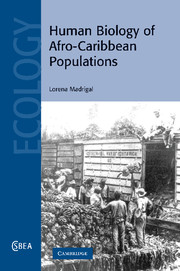Book contents
- Frontmatter
- Contents
- Foreword
- Acknowledgments
- 1 The African slave trade and the Caribbean
- 2 Obesity, hypertension, and non-insulin-dependent diabetes in Afro-Caribbean populations: an evolutionary overview
- 3 Infectious disease epidemiology and Afro-Caribbean populations
- 4 Population genetics of Afro-Caribbean groups
- 5 Demography of Afro-Caribbean groups
- 6 The Afro-Caribbean population in Limón, Costa Rica
- References
- Index
5 - Demography of Afro-Caribbean groups
Published online by Cambridge University Press: 07 August 2009
- Frontmatter
- Contents
- Foreword
- Acknowledgments
- 1 The African slave trade and the Caribbean
- 2 Obesity, hypertension, and non-insulin-dependent diabetes in Afro-Caribbean populations: an evolutionary overview
- 3 Infectious disease epidemiology and Afro-Caribbean populations
- 4 Population genetics of Afro-Caribbean groups
- 5 Demography of Afro-Caribbean groups
- 6 The Afro-Caribbean population in Limón, Costa Rica
- References
- Index
Summary
Demography, biological anthropology, and human biology
Demography, broadly defined, is the study of human populations, with a focus on their fertility, mortality, migration, distribution, and change in size and composition. Fertility or natality is generally defined as the act of childbearing; mortality is death, whereas morbidity is disease. Migration is the movement of people from one place to another. Fertility, mortality, and migration all affect a population's distribution, its size, and its composition (Swedlund and Armelagos, 1976). Some authors prefer to emphasize that demography is quantitative in nature (Riley and McCarthy, 2003; Swedlund and Armelagos, 1976), some that the focus on fertility, morbidity, mortality, and migration is aimed at understanding the structure of human groups (Harrison and Boyce, 1972), and others that the primary focus of demography is the study of mortality and fertility transitions (Beaver, 1975). There are many excellent books on demography and its methods, and the reader is referred to them for a background on the field (Riley and McCarthy, 2003; Rives and Serow, 1984; Shryock et al., 1976; Siegel and Swanson, 2004; Stycos, 1989). We will not discuss the computation of demographic rates or any other methodological tools.
The fields of biological anthropology and human biology have many interests that intersect with demography. Indeed, there are several sources that focus on demographic anthropology (Basu and Aaby, 1998; Dyke and Morrill, 1980; Kertzer and Fricke, 1997a, 1997b; Renne, 1994; Roth, 2004; Swedlund, 1978; Swedlund and Armelagos, 1976; Zubrow, 1976), historical/genealogical demography (Dyke and Morrill, 1980), and even on archive-based human biological research (Herring and Swedlund, 2003).
- Type
- Chapter
- Information
- Human Biology of Afro-Caribbean Populations , pp. 125 - 154Publisher: Cambridge University PressPrint publication year: 2006



